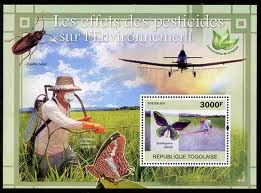Hersteller und Vertreiber von Pflanzenschutzmitteln sind gemäss Paragraph 19 des Pflanzenschutzgesetzes verpflichtet dem Bundesamt für Verbraucherschutz und Lebensmittelsicherheit (BVL) jährlich die Mengen der Pflanzenschutzmittel und darin enthaltenen Wirkstoffe zu melden, die im Inland abgegeben oder ausgeführt wurden. Nachfolgend eine Übersicht (einiger Insektizide) für das Jahr 2005. Imidacloprid gehört zu den meist verwendeten Insektizide in Deutschland. Die Substanz ist sehr giftig für Bienen, wird nur langsam im Boden abgebaut und kann relativ leicht durchsickern ins Grundwasser. Auch die für Bienen sehr giftige neonicotinoide Insektizide Clothianidin und Thiamethoxam haben ein ähnliches sehr ungünstiges Umweltprofil.
Inlandabsatzmenge (t), LD50 für Bienen (in nanogramm, ng) in Klammern:
Dimethoat: 100 - 250 (120 ng, contact), non-persistent in soil, low leachability;
Methiocarb: 100 - 250 (230 ng, contact), non-persistent in soil, low leachability;
Imidacloprid: 25 - 100 (3,7 ng, oral), persistent in soil, high leachability;
Methamidophos: 25 - 100 (220 ng, oral), non-persistent in soil, transition state leachability;
lambda-Cyhalothrin: 25 - 100 (38 ng, contact), non-persistent in soil, low leachability;
Pirimicarb: 10 - 25 (4.000 ng, oral), moderately persistent in soil, transition state leachability;
Alpha-Cypermethrin: 10 - 25 (33 ng, contact), moderately persistent in soil, low leachability;
Beta-Cyfluthrin: 10 - 25 (1 ng, contact), non-persistent in soil, low leachability;
Delthamethrin: 2,5 - 10 (1,5 ng, contact), non-persistent in soil, low leachability;
Clothianidin: 2,5 - 10 (4 ng, oral), very persistent in soil, high leachability;
Thiacloprid: 2,5 - 10 (17.320 ng, oral), non-persistent in soil, low leachability;
Thiamethoxam : 2,5 - 10 (5 ng, oral), moderately persistent in soil, high leachability;
Dichlorvos: 2,5 - 10 (290 ng, oral), non-persistent in soil, low leachability;
Chlorfenvinphos: 2,5 - 10 (550 ng, oral), moderately persistent in soil, transition state leachability;
Pirimiphos-methyl: 2,5 - 10 (› 220 ng, oral), moderately persistent in soil, low leachability;
Fenoxycarb: 2,5 - 10 (› 204.000 ng, contact), non-persistent in soil, low leachability;,
Carbosulfan: 2,5 - 10 (180 ng, oral), non-persistent in soil, low leachability;
Tefluthrin: 2,5 - 10 (280 ng, oral), moderately persistent in soil, low leachability;
zeta-Cypermethrin: 2,5 - 10 (2 ng, contact), moderately persistent in soil, low leachability;
Chlorpyrifos: weniger als 1,0 (59 ng, contact), moderately persistent in soil, low leachability;
Lambda-Cyhalothrin: weniger als 1,0 (38 ng,contact), non-persistent in soil, low leachability.
Ausfuhrmenge (t):
Imidacloprid: mehr als 1000
Dimethoat: mehr als 1000
Clothianidin: 250 -1000
Thiacloprid: 100 - 250
Methiocarb: 25 - 100
Chlorpyrifos: 25 - 100
Beta-Cyfluthrin: 25 - 100
Cyfluthrin: 10 - 25
Methamidophos: 2,5 - 10
Carbosulfan: 2,5 - 10
Deltamethrin: 1,0 - 2,5
Carbofuran: 1,0 - 2,5
Tefluthrin: 1,0 - 2,5
Dichlorvos: weniger als 1,0
Alpha-Cypermethrin: weniger als 1,0
Quelle:
http://www.bvl.bund.de/cln_027/nn_1248996/DE/04__Pflanzenschutzmittel/0…
Umwelteigenschaften der Insektizide aus IUPAC FOOTPRINT Pesticides Properties database:
http://sitem.herts.ac.uk/aeru/iupac/index.htm

- Login om te reageren
